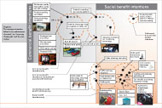Increasingly, many products are being designed with features that intentionally restrict the way the user can behave, or enforce certain modes of behaviour. The same intentions are also evident in the design of many systems and environments. Continued… (+ readers’ comments)
When this research started, I used the term ‘Architectures of Control’ – adopted from Lawrence Lessig – to describe ways in which systems are designed to change or shape users’ behaviour – with the emphasis very much on the ‘control’. A lot of what I was investigating were examples of products/systems/environments forcing the public to conform to the intentions of corporate or political masters, often against their best interests, and the stance I took to it was mostly negative. It was warning people how design may be manipulating their behaviour. That line of thought led to my Master’s dissertation [PDF].
But I continued thinking and learning about the subject, and as the research – and this blog – evolved, I began to realise, aided by lots of comments from readers, that in fact explicit ‘control’ is just one aspect of a behaviour-change spectrum. There are lots of approaches to how intended user behaviour can be designed into a system – what I’ve since tried to clarify with the term Design with Intent – and it need not necessarily be against the user’s interests. It’s not a zero-sum game: it’s quite possible to apply some of these ideas in a way which benefits users as well as society, which is what my PhD is about.
What follows below is the original core of this website, written in 2005: essentially an illustrated version of my dissertation, explaining architectures of control in design in a fairly simple, not-to-in-depth form. Some of the examples used are no longer relevant, and many of the issues are represented a bit simply and without the academic rigour expected of, say, my current research. But I hope it’s an interesting introduction.
Introduction
What are architectures of control in design?
The range of architectures of control
The built environment
The digital environment
Simple control in products
Analysis of examples
Strategic intentions
Case study: printer cartridges
A diagrammatic representation

Related ideas
Artefacts & politics
What things regulate?
Control & networks
Everyday things & persuasive technology
The democracy of innovation
Reactions
The technical community
Consumers’ reactions to DRM
Consumers’ reactions to external control
Implications & possibilities
Some implications
Case study: Optimum Lifetime Products


